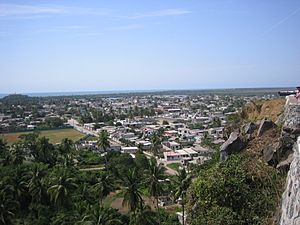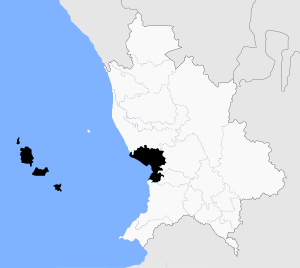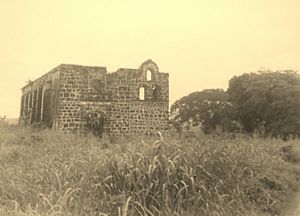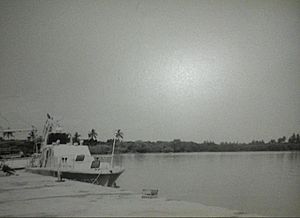San Blas, Nayarit facts for kids
Quick facts for kids
San Blas
|
|
|---|---|

Panorama of San Blas
|
|

Location of San Blas municipality in Nayarit
|
|
| Country | Mexico |
| State | Nayarit |
| Founded | 1530 |
| Founded by | Nuño de Guzmán |
| Seat | San Blas |
| Area | |
| • Municipality | 823.6 km2 (318.0 sq mi) |
| Highest elevation | 30 m (100 ft) |
| Population | |
| • Municipality | 37,478 |
| • Density | 45.505/km2 (117.858/sq mi) |
| • Urban | 10,187 |
| Time zone | UTC-7 (MST (Zona Pacífico)) |
| • Summer (DST) | UTC-7 (MDT (Zona Pacífico)) |
| Postal Code |
63740
|
| Area Code | 323 |
San Blas is a town and a municipality located on the Pacific coast of Mexico. It is found in the state of Nayarit. San Blas is a popular port and tourist spot. It is about 160 kilometres (99 mi) north of Puerto Vallarta. The town itself has a population of 8,707 people. The wider municipality of San Blas had a population of 37,478 in 2005. The Islas Marías, a group of islands, are also part of this municipality. These islands are now an environmental and cultural education center.
Contents
History of San Blas
San Blas became an important port in 1768. It was founded by José de Gálvez. The port was a starting point for military trips. These trips went to areas like Sinaloa, Sonora, and California. San Blas was different from other ports like Acapulco. It was mainly for military use, not just trade.
A shipyard was also built in San Blas. This allowed ships to be built and repaired there. From 1774, navy ships used San Blas to deliver mail to Manila in the Philippines. This connection helped link New Spain (Mexico) with Asia.
Challenges of the Port
San Blas faced many challenges as a port. The harbor was very small. It could only hold about four ships at a time. Mud and sand from the nearby Río Grande de Santiago river often filled the harbor. This meant it needed to be cleaned regularly.
The climate was also difficult. From July to October, it was very humid with heavy rains. The area was surrounded by mangrove swamps. This led to many mosquitoes. People often got sick with diseases like dysentery and malaria. Despite these problems, San Blas was useful. It was close to Guadalajara and Mexico City. The area also had plenty of wood for building ships.
Important Buildings and Ruins
A fort was built in 1770 on a hillside. It was made to protect the town's trade. The front of the fort has stone carvings of Spanish kings. Behind the fort are the ruins of the Church of Our Lady of the Rosary. This church was built in 1769.
The church ruins once held bronze bells. These bells are said to have inspired a famous poem. It was called "The Bells of San Blas" by Henry Wadsworth Longfellow. You can also see the ruins of a 19th-century customs house. It is located near the main plaza.
During the time of Spanish rule, the forests around San Blas provided wood. This wood was used to build ships. These ships traded with the Philippines and were part of the Manila galleon trade. Later, shipping moved to other ports.
Modern Developments
In recent years, there have been some issues with land use. In 2021, local farmers protested against a luxury tourist project. They said the developer had cut down trees without permission. They also claimed the developer took over a public access road and a beach.
San Blas and California
San Blas played a key role in supplying Spain's colony in California. Two supply ships from San Blas would arrive in California once a year. For example, on March 12, 1768, Junípero Serra left San Blas for California. He was a very important figure in the California Missions.
On March 16, 1775, the ship San Carlos sailed from San Blas. It was heading to San Francisco Bay. This ship was built at the shipyard on the Santiago River. It was 58 feet long and had a crew of 30 people.
San Blas and the Pacific Northwest
San Blas was also a base for Spanish trips to the Pacific Northwest. People were willing to pay a lot for otter furs. This encouraged exploration in the region. From 1789 to 1795, San Blas helped set up and maintain a Spanish post at Nootka Sound. This was in what is now British Columbia.
For about 20 years in the late 1700s, San Blas was one of the busiest ports on the Pacific coast. It was a major center for shipbuilding. It was as important as Acapulco, which was the eastern end of the Manila galleon trade route. At its busiest, San Blas had 30,000 people living there. It became the main office for Spain's General of the Southern Seas.
Climate in San Blas
| Climate data for San Blas | |||||||||||||
|---|---|---|---|---|---|---|---|---|---|---|---|---|---|
| Month | Jan | Feb | Mar | Apr | May | Jun | Jul | Aug | Sep | Oct | Nov | Dec | Year |
| Mean daily maximum °C (°F) | 28.0 (82.4) |
28.2 (82.8) |
28.8 (83.8) |
30.2 (86.4) |
31.9 (89.4) |
33.3 (91.9) |
34 (93) |
34.1 (93.4) |
33.8 (92.8) |
33.8 (92.8) |
31.7 (89.1) |
29.0 (84.2) |
31.4 (88.5) |
| Daily mean °C (°F) | 22.1 (71.8) |
22.1 (71.8) |
22.5 (72.5) |
24 (75) |
26.3 (79.3) |
28.8 (83.8) |
29.3 (84.7) |
29.4 (84.9) |
29.2 (84.6) |
28.8 (83.8) |
26.2 (79.2) |
23.4 (74.1) |
26 (79) |
| Mean daily minimum °C (°F) | 16 (61) |
15.9 (60.6) |
16.2 (61.2) |
18 (64) |
20.7 (69.3) |
24.3 (75.7) |
24.7 (76.5) |
24.8 (76.6) |
24.7 (76.5) |
24 (75) |
20.6 (69.1) |
18 (64) |
20.6 (69.1) |
| Average precipitation mm (inches) | 20 (0.8) |
13 (0.5) |
5.1 (0.2) |
0 (0) |
20 (0.8) |
130 (5.1) |
340 (13.3) |
390 (15.4) |
360 (14.2) |
120 (4.9) |
13 (0.5) |
23 (0.9) |
1,440 (56.8) |
| Source: Weatherbase | |||||||||||||
Fun Things to Do in San Blas
The San Blas area is well-known for its surfing. Playa de Matanchen was once famous for having the longest surfable wave in the world. It was even listed in the Guinness Book of World Records. However, a hurricane later filled part of the bay with sand. This made the waves much smaller.
The area is also great for birdwatching. Many different kinds of migratory birds live in the estuaries and palm forests nearby. Birdwatchers often count over 200 species here. In 1983, a record 292 species were spotted.
San Blas is also a way to get to La Tovara park. This park is a large mangrove forest and a protected nature area. You can explore it by taking a small boat.
There is an old hotel called Playa Hermosa. It was built in 1951. In the 1960s, Hollywood actors like Lee Marvin visited San Blas for its fishing. The hotel is now empty.
Local Economy
The economy of San Blas depends on farming, fishing, and tourism. Farmers grow crops like beans, sorghum, tobacco, corn, watermelon, and citrus fruits. There are also many cattle raised here. Shrimp are farmed in the large marshlands.
See also
 In Spanish: San Blas (Nayarit) para niños
In Spanish: San Blas (Nayarit) para niños




